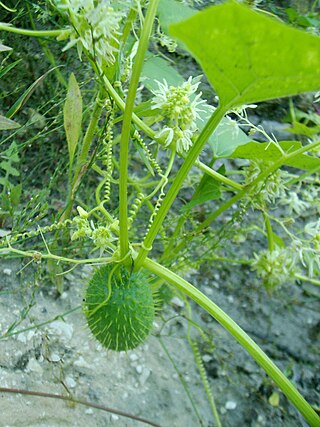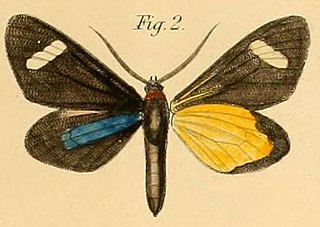
Gracillariidae is an important family of insects in the order Lepidoptera and the principal family of leaf miners that includes several economic, horticultural or recently invasive pest species such as the horse-chestnut leaf miner, Cameraria ohridella.

Carposinoidea, the "fruitworm moths", is a superfamily of insects in the lepidopteran order. The superfamily is also known as Copromorphoidea, which is a junior synonym. These moths are small to medium-sized and are broad-winged bearing some resemblance to the superfamilies Tortricoidea and Immoidea. The antennae are often "pectinate" especially in males, and many species of these well camouflaged moths bear raised tufts of scales on the wings and a specialised fringe of scales at the base of the hindwing sometimes in females only; there are a number of other structural characteristics. The position of this superfamily is not certain, but it has been placed in the natural group of "Apoditrysia" "Obtectomera", rather than with the superfamilies Alucitoidea or Epermenioidea within which it has sometimes previously been placed, on the grounds that shared larval and pupal characteristics of these groups have probably evolved independently. It has been suggested that the division into two families should be abandoned.

Metoeca is a genus of moths of the family Crambidae. It contains only one species Metoeca foedalis, which has a wide distribution, including the Democratic Republic of Congo, Equatorial Guinea, South Africa, China, Japan, Taiwan, Thailand, Myanmar and Australia (Queensland).
Eunimbatana is a monotypic moth genus of the family Erebidae. Its only species, Eunimbatana lobata, is found in Guinea. Both the genus and the species were first described by David Stephen Fletcher and Pierre Viette in 1955.

Paralephana is a genus of moths of the family Erebidae. It was described by George Hampson in 1926.

Acanthosphinx is a monotypic moth genus in the family Sphingidae erected by Per Olof Christopher Aurivillius in 1891. Its only species, Acanthosphinx guessfeldti, the widow sphinx, was first described by Hermann Dewitz in 1879. It is known from forests from Sierra Leone to the Congo, Angola, Zambia, Malawi, Tanzania and Uganda.

Echinocystis is a monotypic genus in the gourd family, Cucurbitaceae. The sole species is E. lobata, commonly called wild cucumber, prickly cucumber or bur cucumber. It is an annual, sprawling plant that is native to North America.
Macrotarsipus albipunctus is a moth of the family Sesiidae. It was described by George Hampson in 1893 and is known from Myanmar and central Vietnam. There are also records from Kenya and Malawi.

Urena lobata, commonly known as Caesarweed or Congo jute, is a tender perennial, variable, erect, ascendant shrub or subshrub measuring up to 0.5 meters (1.6 ft) to 2.5 meters (8.2 ft) tall. The stems are covered with minute, star-like hairs and often tinged purple. Considered a weed, it is widely distributed in the tropics, including in Brazil and Southeast Asia.

Hipoepa fractalis is a species of moth of the family Noctuidae first described by Achille Guenée in 1854. It is found in Taiwan, China, Japan, Kenya, Korea, India, Malaysia, Nigeria, Indonesia, the Philippines, Thailand, Cape Verde, Réunion, Saudi Arabia, South Africa, Sri Lanka, Uganda, Yemen and Australia.
Cirrhochrista grabczewskyi is a moth of the family Crambidae. It is found in subtropical Africa from Senegal to Kenya, and is also known from Zimbabwe and South Africa.
Phyllonorycter adderis is a moth of the family Gracillariidae. It is found in south-western Rwanda in montane, closed canopy forests at an altitude of about 1,800 metres.

Rothia rhaeo is a moth of the family Noctuidae first described by Herbert Druce in 1894. This moth occurs in Madagascar, Uganda and in South Africa.

Pitthea perspicua is a moth of the family Geometridae first described by Carl Linnaeus in his 1758 10th edition of Systema Naturae. It is found in Angola, Cameroon and the Democratic Republic of the Congo.

Spidia fenestrata is a moth in the family Drepanidae. It was described by Arthur Gardiner Butler in 1878. It is found in Angola, Cameroon, the Democratic Republic of the Congo, Ghana, Guinea, Ivory Coast, Liberia, Nigeria, Sierra Leone and Uganda.

Phiala nigrolineata is a moth in the family Eupterotidae. It was described by Per Olof Christopher Aurivillius in 1903. It is found in the Democratic Republic of the Congo, South Africa, Togo, Uganda and Zambia.

Hibrildes crawshayi is a moth in the family Eupterotidae. It was described by Arthur Gardiner Butler in 1896. It is found in the Democratic Republic of the Congo (Katanga), Malawi, South Africa, Tanzania, Zambia and Zimbabwe.

Stenoglene obtusus is a moth in the family Eupterotidae. It was described by Francis Walker in 1864. It is found in Burundi, the Democratic Republic of the Congo, Kenya, Malawi, Mozambique, South Africa, Tanzania and Zimbabwe.
Dichomeris scenites is a moth in the family Gelechiidae. It was described by Edward Meyrick in 1909. It is found in South Africa.
Eretmocera scatospila is a moth of the family Scythrididae. It was described by Philipp Christoph Zeller in 1852. It is found in Botswana, Democratic Republic of Congo, Gambia, Ghana, Kenya, Namibia, Nigeria and South Africa.












